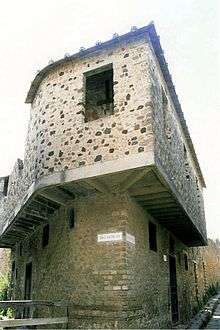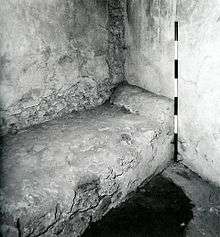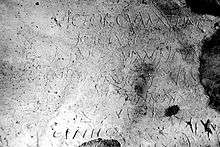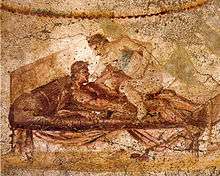Lupanar (Pompeii)

The Lupanar of Pompeii is the most famous brothel in the ruined Roman city of Pompeii. It is of particular interest for the erotic paintings on its walls. Lupanar is Latin for "brothel". The Pompeii lupanar is also known as Lupanare Grande.
Location
The Lupanar (VII, 12, 18–20) is located approximately two blocks east of the forum at the intersection of Vico del Lupanare and Vico del Balcone Pensile.[1]
Brothels

The Roman word for brothel was lupanar, meaning a wolf den, and a prostitute was called a lupa.[2][3]
Early Pompeian excavators, guided by the strict modesty of the time period, quickly classified any building containing erotic paintings as brothels. Using this metric, Pompeii had 35 lupanares. Given a population of ten thousand in Pompeii during the first century CE, this leaves one brothel per 286 people or 71 adult males. Using a stricter standard for identifying brothels brings the number to a more realistic figure including nine single room establishments and the Lupanar at VII, 12, 18–20. [4]
Brothels during this period were typically small with only a few rooms. The Lupanar was the largest of the brothels found in Pompeii with 10 rooms. Like other brothels, rooms in the Lupanar were plainly furnished. A mattress on a brick platform served as a bed. [5]
Graffiti


There have been 134 graffiti transcribed from the Lupanar at Pompeii. The presence of this graffiti served as one of the criteria for identifying the building as a brothel.[1]
Examples of graffiti from the Lupanar include:
- Hic ego puellas multas futui ("Here I fucked many girls").[6]
- Felix bene futuis ("Lucky guy, you fuck well," a prostitute's blandishment to her client,[7] or "Lucky guy, you get a good fuck"[8]).
Other examples can be traced to other locations in Pompeii. Given that persons of wealth generally did not visit brothels because of the availability of mistresses or slave concubines, the names cannot be connected to known historical figures. The graffiti do tell stories, however. Various authors respond to each other's carvings in a sort of dialogue.[9]
See also
| Wikimedia Commons has media related to Lupanar (Pompeii). |
- Erotic art in Pompeii and Herculaneum
- Prostitution in ancient Rome
- Roman graffiti
- Sex in the Ancient World Pompeii History Channel Documentary
Notes
- 1 2 "Seeing the Past: Sex, Sight, and Societas in the Lupanar, Pompeii". Archived from the original Check
|url= - ↑ Mazzoni, Cristina (2010). She-wolf : the story of a Roman icon. Cambridge [England]: Cambridge University Press. ISBN 978-0-521-19456-3.
- ↑ McGinn, Thomas A. J. (2004). The economy of prostitution in the Roman world : a study of social history & the brothel ([Reprinted]. ed.). Ann Arbor, MI: Univ. of Michigan Press [u.a.] pp. 7–8. ISBN 9780472113620.
- ↑ John R. Clarke (1998). Looking at lovemaking: constructions of sexuality in Roman art, 100 B. C.-A. D. 250. Berkeley: University of California Press. ISBN 0-520-20024-1.
- ↑ Koninklijke Brill NV, Leiden, 2002ff. BNP 2, 790–791
- ↑ "CIL IV. 2175".
- ↑ CIL IV. 2175; observation by J.N. Adams, The Latin Sexual Vocabulary (Johns Hopkins University Press, 1982, 1990), p. 120 online.
- ↑ Thomas A McGinn, The Economy of Prostitution in the Roman World (University of Michigan Press, 2004), p. 162.
- ↑ Franklin, James L. (1986-04-). "Games and a Lupanar: Prosopography of a Neighborhood in Ancient Pompeii". The Classical Journal 81 (4): 319–328. JSTOR 3297215. Check date values in:
|date=(help);
| ||||||||||||||||||||||||||||||||||||||
Coordinates: 40°45′01″N 14°29′12″E / 40.7503°N 14.4868°E